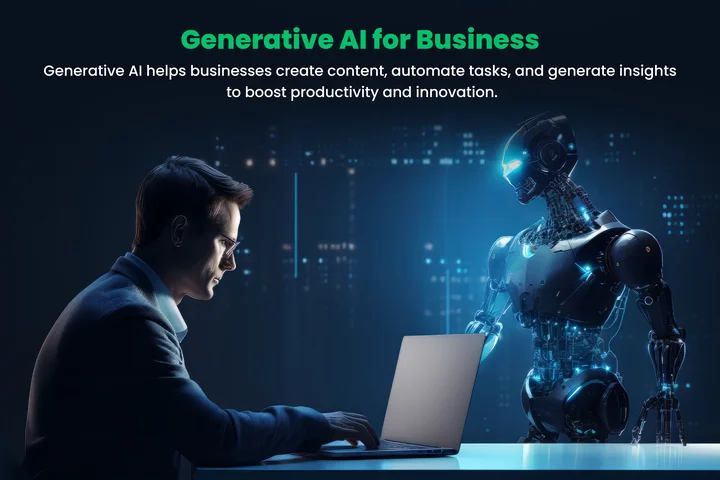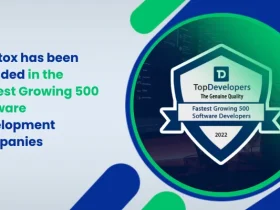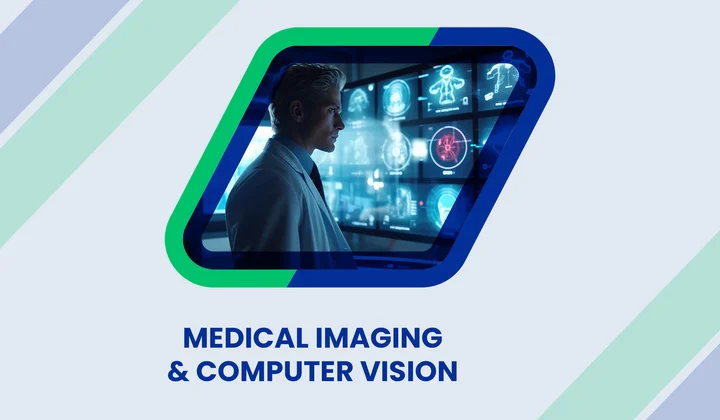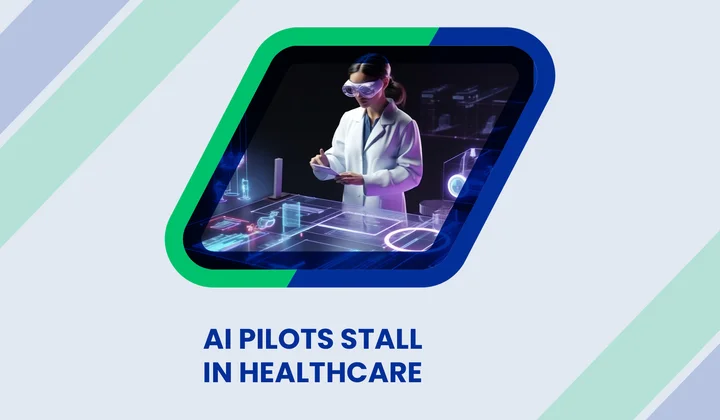Has generative AI for business already become a core part of strategy in 2026, moving from pilot projects to mainstream adoption?
Evidence from McKinsey shows that companies adopting generative AI tools at scale report up to a 40 percent faster time-to-market compared with competitors who have not yet embraced them. This shift highlights that generative artificial intelligence is no longer experimental but a driver of real competitive advantage.
Organizations are now using generative AI to produce marketing content, design visuals, draft reports, generate prototypes, and even automate coding tasks. These applications accelerate operations and allow teams to focus on high-impact decisions instead of repetitive work.
Additionally, generative AI in 2026 delivers more accurate, multilingual, and context-aware outputs than earlier models. This reliability makes it practical for customer support, product innovation, and enterprise solutions aimed at improving productivity initiatives.
This blog explains 10 important reasons why generative AI for business in 2026 is essential and how organizations can apply it effectively.
So, let’s get started on our blog with an understanding of generative AI for business!
What Is Generative AI for Business?
Generative AI is a category of artificial intelligence designed to produce new content, text, images, code, audio, or video from prompts or existing data. Organizations use generative AI in business to accelerate content creation, automate design tasks, enhance customer support, and generate new product concepts.

Table of Contents
What sets generative AI for business in 2026 apart is the maturity of its models, the scale and diversity of available data, and the efficiency of current computing infrastructure. Advanced architectures enable real-time text generation, multilingual outputs, and context-aware responses that improve customer and employee experiences.
indispensable for businesses in 2026
Generative AI tools offer several capabilities:
- Content creation for marketing campaigns, social media, newsletters, and product descriptions.
- Creative design, including image, video, or multimedia generation, tailored to brand requirements.
- Automated code generation and document summarization to streamline internal workflows.
- Idea and prototype generation to help teams test and refine concepts faster.
Gen AI productivity is about freeing employees to focus on strategic thinking, innovation, and decision-making while AI manages repetitive creation tasks. In business, generative AI underpins that shift.
But how are companies actually applying generative AI to their operations in 2026?
Many are embedding it into customer service chatbots capable of natural, human-like conversations. Others use it to draft reports, create proposals, or surface insights from massive data sets. Leading enterprises are weaving these capabilities into their core business strategies to stay competitive.
What about the risks?
Issues such as data privacy, biased outputs, and model hallucinations remain significant. To use generative AI responsibly, organizations need strong governance, ethical guidelines, and ongoing monitoring alongside their deployments.
Struggling with time-consuming workflows? Cut content creation, reporting, and customer support time in half with Generative AI.
With these opportunities and considerations in mind, let’s explore the top 10 reasons why generative AI is becoming indispensable for businesses in 2026.

Reason 1: Driving AI-Driven Innovation Across Operations
Generative AI empowers organizations to push innovation deeper into their operations by automating routine work, generating fresh ideas, and revealing new opportunities for improvement. Businesses can make confident, data-driven decisions and explore innovative solutions more quickly by integrating generative AI into routine processes.
Some practical ways generative AI drives innovation include:
- Rapid ideation and prototyping that let teams test new products or services in days instead of weeks.
- Spotting bottlenecks and suggesting smarter workflows to save time and resources across departments.
This approach not only accelerates day-to-day operations but also frees employees to focus on high-impact strategic initiatives, turning innovation from a one-off event into a continuous, scalable process.
Reason 2: Improving Productivity and Efficiency with Generative AI Tools
Generative AI is fundamentally reshaping how organizations work by boosting productivity and simplifying workflows. Instead of spending hours on repetitive, time-consuming tasks, such as drafting marketing content, analyzing large data sets, or preparing reports, teams can now redirect their focus toward high-value activities that drive growth.
Specifically, there are three main ways in which generative AI improves efficiency:
- First, it enables automated content creation for marketing campaigns, newsletters, and product descriptions.
- Next, it supports advanced data analysis, allowing teams to extract insights faster and make more informed decisions.
- Finally, it drives workflow optimization, reducing manual errors and saving hours of employee time across departments.
As a result, organizations adopting generative AI at scale achieve notable productivity gains and bring new offerings to market faster than competitors who still rely on manual processes. Ultimately, by embedding generative AI tools into everyday operations, businesses can boost productivity, reduce costs, and free their teams to concentrate on strategic innovation.
Reason 3: Enabling Smarter Decision-Making Through AI-Powered Solutions
The third reason is that generative AI solutions empower businesses to make smarter, faster decisions. In today’s environment of ever-growing and complex data, these tools help analyze information quickly and deliver actionable insights. As a result, teams can rely on data-driven choices rather than intuition alone.
More specifically, generative AI brings several key benefits:
- Real-time insights: Organizations can access up-to-date information instantly, which speeds up decision-making.
- Predictive analytics: Generative AI can forecast trends, customer behavior, and operational challenges before they unfold.
- Better risk management: Early detection of potential issues helps minimize costly mistakes.
- Optimized strategy: Data-backed insights enable leaders to align operations and improve overall outcomes.
Consequently, organizations that leverage generative AI for decision-making can act proactively, remain agile, and gain a sustained competitive advantage in a fast-changing market.
Reason 4: Reducing Business Costs Using Generative AI Applications
Generative AI applications help businesses significantly lower costs by automating repetitive and time-consuming tasks. For example, AI-driven virtual assistants and chatbots in customer service can handle routine inquiries around the clock, freeing human agents to focus on more complex issues while reducing staffing expenses.
Moreover, cost savings also come from optimizing resources and workflows. Retailers now use generative AI to forecast inventory demand more accurately, preventing overstock and minimizing waste. In manufacturing, generative AI–powered predictive maintenance identifies potential equipment failures before they occur, avoiding expensive downtime and improving asset utilization.
In addition, generative AI helps reduce costly errors across operations. For instance, AI-enabled accounting tools can detect anomalies in transactions, lowering the risk of mistakes and fraud. Businesses can boost overall profitability, cut costs, and improve operational efficiency by implementing generative AI in these ways, freeing up teams to work on higher-value projects.
Reason 5: Personalizing Customer Experiences with AI Business Applications
How can businesses deliver truly personalized experiences to every customer? Generative AI applications make this possible by analyzing customer behavior, preferences, and purchase history to create real-time, tailored interactions that feel unique to each individual.
For example, eCommerce platforms powered by generative AI recommend products based on past purchases, browsing patterns, and even seasonal trends. Similarly, streaming services use these models to suggest content that matches a user’s viewing habits, keeping engagement high and satisfaction levels rising.
In addition, generative AI enables highly targeted marketing campaigns. Businesses can send personalized offers, emails, or notifications that resonate with each customer segment, which increases conversion rates while strengthening loyalty. By utilizing generative AI for personalization, businesses can create enduring customer experiences that increase retention, spur growth, and set their brand apart in a crowded market.
Reason 6: Supporting Business Process Automation and Workflow Simplification
Generative AI applications are redefining how businesses manage repetitive and time-consuming tasks. For example, companies that use generative AI for HR processes such as employee onboarding and payroll management report up to 30% faster processing times while significantly reducing manual errors.
In finance, generative AI–powered tools handle invoice processing and expense tracking more efficiently than traditional systems. Beyond individual departments, generative AI also simplifies complex workflows across the entire organization.
These improvements not only save time but also enhance scalability, enabling businesses to handle higher workloads without increasing headcount or compromising quality. Key benefits of generative AI–powered process automation include:
- Time savings: Automates routine tasks and accelerates workflows.
- Error reduction: Minimizes mistakes in payroll, invoicing, and data entry.
- Operational efficiency: Streamlines cross-department processes for smoother operations.
- Scalability: Supports growing workloads without adding extra staff.
Organizations can increase productivity, cut expenses, and free up staff members for more strategic projects by integrating generative AI into business operations.
Reason 7: Expanding AI Business Strategy for Small and Large Enterprises
Small and medium-sized enterprises (SMEs) are increasingly turning to generative AI to compete on a global scale. For example, small eCommerce businesses now use generative AI–powered recommendation engines to boost sales and deliver personalized customer experiences, achieving conversion rate increases of up to 25%.
Meanwhile, large enterprises are implementing generative AI across multiple departments, from supply chain optimization to predictive maintenance. Industry leaders like Amazon and Siemens leverage generative AI to analyze massive datasets, improve operational efficiency, and make strategic decisions faster, resulting in significant cost savings and higher ROI.
Ultimately, adopting generative AI allows businesses of all sizes to scale smarter and faster. Integrating it into the overall business strategy ensures a stronger competitive advantage, higher efficiency, and sustained long-term growth.
Reason 8: Opening New Revenue Streams Through Generative AI Use Cases
Generative AI is helping businesses create entirely new products and services, thereby opening up additional revenue streams. For instance, media companies now use generative AI to produce personalized content such as news summaries, marketing materials, and social media posts, cutting content creation time by up to 50% while reaching wider audiences.
In addition, retailers and eCommerce platforms apply generative AI to design custom products or recommend unique bundles tailored to individual customers. Similarly, financial institutions employ generative AI–driven insights to deliver personalized investment strategies, generating additional advisory fees and increasing customer engagement.
By integrating generative AI into their operations, businesses can innovate faster, diversify their offerings, and open fresh revenue channels. Generative AI not only increases revenue potential but also strengthens market positioning and customer loyalty.
Reason 9: Strengthening Digital Transformation with Enterprise AI Solutions
Generative AI solutions are expediting digital transformation services by embedding intelligence across every area of business operations. Instead of treating AI as an add-on, companies are now integrating generative AI to improve processes, enhance decision-making, and modernize workflows at scale.
Moreover, generative AI boosts both customer engagement and operational efficiency. For example, banks use it to detect fraud in real time and deliver personalized services, while manufacturing firms rely on it to optimize production lines and monitor equipment performance proactively.
Key benefits of generative AI–driven digital transformation include:
- Automating repetitive tasks and streamlining procedures.
- Improving decision-making through deeper, AI-powered insights.
- Increasing customer interaction by personalizing experiences at scale.
- Reducing inefficiencies and simplifying complex operations.
- Supporting overall digital transformation initiatives with data-driven intelligence.
Businesses can stay ahead in a market that is becoming more and more competitive by implementing generative AI solutions to modernize operations, increase agility, and find new growth prospects.
Reason 10: Preparing Businesses for the Future of AI in Business
As we look ahead, integrating generative AI into business strategies is essential. Companies that proactively adopt these technologies are positioning themselves for long-term success. In fact, a recent report by AlphaSense shows that over 80% of organizations increased their use of generative AI in 2025, signaling a major shift toward AI-driven business models.
Looking forward, the future of generative AI in business will involve deeper integration across all functions, from customer service to supply chain management. Companies that fail to evolve risk falling behind as generative AI becomes a fundamental driver of competitiveness and innovation.
Important considerations for preparing for the future of generative AI include:
- Investing in AI literacy and training to upskill employees.
- Building scalable AI infrastructure and systems to handle growing workloads.
- Exploring innovative use cases for generative AI beyond initial pilots.
- Continuously monitoring AI trends and market shifts to stay ahead.
- Integrating generative AI into long-term strategic planning for sustainable growth.
Businesses can stay competitive in a market that is changing quickly and be ready to implement generative AI successfully throughout their operations by concentrating on these areas.
Frequently Asked Questions (FAQs)
2. How Do Companies Use Generative AI in 2026?
Businesses are using generative AI for content creation, designing visuals, drafting reports, coding automation, and AI-powered customer service. It also helps analyze complex datasets, forecast trends, and optimize internal processes for better operational efficiency.
3. Is Generative AI Suitable for Small Businesses?
Yes. Small and medium-sized enterprises (SMEs) can leverage generative AI to compete with larger organizations. It enables automation of routine tasks, personalized customer interactions, and data-driven decision-making without requiring large teams or resources.
4. Can Generative AI Reduce Business Costs?
Absolutely! Generative AI minimizes manual effort, prevents errors, and optimizes workflows. It helps businesses save on staffing, reduce operational inefficiencies, and avoid costly mistakes, contributing to higher profitability and long-term growth.
Final Take: Why Your Business Needs Generative AI in 2026
In 2026, more than eight out of ten organizations report expanding their use of generative AI beyond pilot projects, turning it into a core part of daily operations. Your team may already be experimenting with these tools, but the question is about using them effectively to outperform competitors.
At the same time, this rapid adoption also prepares organizations for the future of AI in business by building the skills, infrastructure, and governance they need to stay competitive. Businesses that start integrating generative AI services for business in 2026 can strengthen productivity, create new revenue opportunities, and deliver better experiences to their customers.
The question of how soon your teams can start integrating generative AI into daily operations becomes crucial for any organization when considering these advantages collectively.
Too many repetitive tasks are slowing your team down? Shift the burden to Generative AI and let your employees focus on strategic growth.








Share your thoughts about this blog!